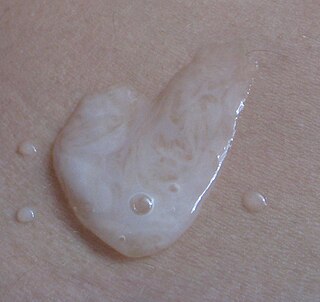Orgasm or sexual climax is the sudden release of accumulated sexual excitement during the sexual response cycle, characterized by intense sexual pleasure resulting in rhythmic, involuntary muscular contractions in the pelvic region. Orgasms are controlled by the involuntary or autonomic nervous system and experienced by both males and females; the body's response includes muscular spasms, a general euphoric sensation, and, frequently, body movements and vocalizations. The period after orgasm is typically a relaxing experience, after the release of the neurohormones oxytocin and prolactin, as well as endorphins.

Pre-ejaculate is a clear, colorless, viscous fluid that is emitted from the urethra of the penis during sexual arousal and in general during sexual activity. It is similar in composition to semen but has distinct chemical differences. The presence of sperm in the fluid is variable from low to absent. Pre-ejaculate functions as a lubricant and an acid neutralizer.
A wet dream, sex dream, or sleep orgasm, is a spontaneous occurrence of sexual arousal during sleep that includes ejaculation and orgasm for a male, and vaginal lubrication and/or orgasm for a female.

The human female reproductive system is made up of the internal and external sex organs that function in the reproduction of new offspring. The reproductive system is immature at birth and develops at puberty to be able to release matured ova from the ovaries, facilitate their fertilization, and create a protective environment for the developing fetus during pregnancy. The female reproductive tract is made of several connected internal sex organs—the vagina, uterus, and fallopian tubes—and is prone to infections. The vagina allows for sexual intercourse, and is connected to the uterus at the cervix. The uterus accommodates the embryo by developing the uterine lining.

Sperm competition is the competitive process between spermatozoa of two or more different males to fertilize the same egg during sexual reproduction. Competition can occur when females have multiple potential mating partners. Greater choice and variety of mates increases a female's chance to produce more viable offspring. However, multiple mates for a female means each individual male has decreased chances of producing offspring. Sperm competition is an evolutionary pressure on males, and has led to the development of adaptations to increase male's chance of reproductive success. Sperm competition results in a sexual conflict between males and females. Males have evolved several defensive tactics including: mate-guarding, mating plugs, and releasing toxic seminal substances to reduce female re-mating tendencies to cope with sperm competition. Offensive tactics of sperm competition involve direct interference by one male on the reproductive success of another male, for instance by mate guarding or by physically removing another male's sperm prior to mating with a female. For an example, see Gryllus bimaculatus.
Insemination is the introduction of sperm (semen) into a female or hermaphrodite's reproductive system in order to fertilize the ovum through sexual reproduction. The sperm enters into the uterus of a mammal or the oviduct of an oviparous (egg-laying) animal. Female humans and other mammals are inseminated during sexual intercourse or copulation, but can also be inseminated by artificial insemination.

Anisogamy is a form of sexual reproduction that involves the union or fusion of two gametes that differ in size and/or form. The smaller gamete is male, a sperm cell, whereas the larger gamete is female, typically an egg cell. Anisogamy is predominant among multicellular organisms. In both plants and animals, gamete size difference is the fundamental difference between females and males.

The human reproductive system includes the male reproductive system, which functions to produce and deposit sperm, and the female reproductive system, which functions to produce egg cells and to protect and nourish the fetus until birth. Humans have a high level of sexual differentiation. In addition to differences in nearly every reproductive organ, there are numerous differences in typical secondary sex characteristics.

Human reproduction is sexual reproduction that results in human fertilization to produce a human offspring. It typically involves sexual intercourse between a sexually mature human male and female. During sexual intercourse, the interaction between the male and female reproductive systems results in fertilization of the ovum by the sperm to form a zygote. While normal cells contain 46 chromosomes, gamete cells only contain 23 single chromosomes, and it is when these two cells merge into one zygote cell that genetic recombination occurs and the new zygote contains 23 chromosomes from each parent, giving it 46 chromosomes. The zygote then undergoes a defined development process that is known as human embryogenesis, and this starts the typical 9-month gestation period that is followed by childbirth. The fertilization of the ovum may be achieved by artificial insemination methods, which do not involve sexual intercourse. Assisted reproductive technology also exists.

Sexual conflict or sexual antagonism occurs when the two sexes have conflicting optimal fitness strategies concerning reproduction, particularly over the mode and frequency of mating, potentially leading to an evolutionary arms race between males and females. In one example, males may benefit from multiple matings, while multiple matings may harm or endanger females due to the anatomical differences of that species. Sexual conflict underlies the evolutionary distinction between male and female.

Masturbation is a form of autoeroticism in which a person sexually stimulates their own genitals for sexual arousal or other sexual pleasure, usually to the point of orgasm. Stimulation may involve use of hands, everyday objects, sex toys, or more rarely, the mouth. Masturbation may also be performed with a sex partner, either masturbating together or watching the other partner masturbate.

Semen quality is a measure of male fertility, a measure of the ability of sperm in semen to accomplish fertilization. Semen quality involves both sperm quantity and quality. Semen quality is a major factor for fertility.

In human anatomy, the penis is an external sex organ through which males urinate and ejaculate. Together with the testes and surrounding structures, the penis functions as part of the male reproductive system.
Human sexuality is the way people experience and express themselves sexually. This involves biological, psychological, physical, erotic, emotional, social, or spiritual feelings and behaviors. Because it is a broad term, which has varied with historical contexts over time, it lacks a precise definition. The biological and physical aspects of sexuality largely concern the human reproductive functions, including the human sexual response cycle.

Semen, also known as seminal fluid, is a bodily fluid that contains spermatozoa. Spermatozoa are secreted by the male gonads and other sexual organs of male or hermaphroditic animals and can fertilize the female ovum. In placental mammals, semen also contains secretions from the male accessory glands and is discharged from the penis through the urethral orifice during ejaculation. In humans, seminal fluid contains several components besides spermatozoa: proteolytic and other enzymes as well as fructose are elements of seminal fluid which promote the survival of spermatozoa and provide a medium through which they can move or "swim". The fluid is adapted to be discharged deep into the vagina, so the spermatozoa can pass into the uterus and form a zygote with an egg.

Ejaculation is the discharge of semen from the penis through the urethra. It is the final stage and natural objective of male sexual stimulation, and an essential component of natural conception. After forming an erection, many men emit pre-ejaculatory fluid during stimulation prior to ejaculating. Ejaculation involves involuntary contractions of the pelvic floor and is normally linked with orgasm. It is a normal part of male human sexual development.

Robin Baker is a British novelist, popular science writer, lecturer and broadcaster. A best-selling author in the field of sexual biology his books have been translated into 27 different languages. These include the international bestseller Sperm Wars which was based on his own lab's original research on human sexuality. His work and ideas on the evolution of human behaviour have been featured in many radio and television programmes around the world.
Female copulatory vocalizations, also called female copulation calls or coital vocalizations, are produced by female primates, including human females, and female non-primates. They are not purposeful, but instead are evolutionary and are spontaneously produced by female primates, including women, to encourage her partner to produce good-quality sperm during the mating process. Copulatory vocalizations usually occur during copulation and are hence related to sexual activity. Vocalizations that occur before intercourse, for the purpose of attracting mates, are known as mating calls.

Animal non-reproductive sexual behavior encompasses sexual activities that non-human animals participate in which do not lead to the reproduction of the species. Although procreation continues to be the primary explanation for sexual behavior in animals, recent observations on animal behavior have given alternative reasons for the engagement in sexual activities by animals. Animals have been observed to engage in sex for social interaction bonding, exchange for significant materials, affection, mentorship pairings, sexual enjoyment, or as demonstration of social rank. Observed non-procreative sexual activities include non-copulatory mounting, oral sex, genital stimulation, anal stimulation, interspecies mating, same-sex sexual interaction, and acts of affection, although it is doubted that they have done this since the beginning of their existence. There have also been observations of sex with cub participants, as well as sex with dead animals.

Sperm competition is a form of post-copulatory sexual selection whereby male sperm simultaneously physically compete to fertilize a single ovum. Sperm competition occurs between sperm from two or more rival males when they make an attempt to fertilize a female within a sufficiently short period of time. This results primarily as a consequence of polyandrous mating systems, or due to extra-pair copulations of females, which increases the chance of cuckoldry, in which the male mate raises a child that is not genetically related to him. Sperm competition among males has resulted in numerous physiological and psychological adaptations, including the relative size of testes, the size of the sperm midpiece, prudent sperm allocation, and behaviors relating to sexual coercion, however this is not without consequences: the production of large amounts of sperm is costly and therefore, researchers have predicted that males will produce larger amounts of semen when there is a perceived or known increase in sperm competition risk.














